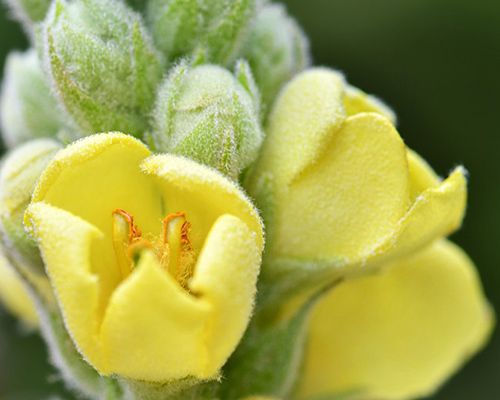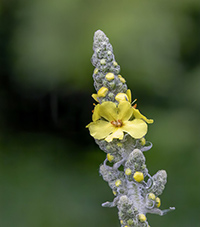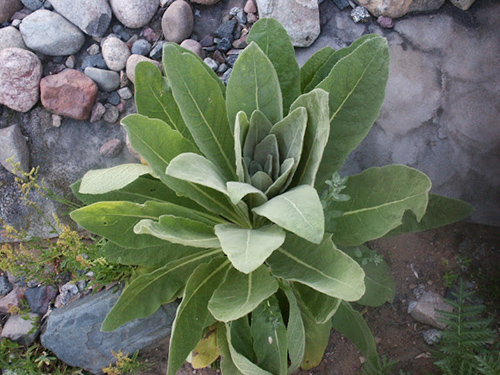Contents
Dioscorides and Hippocrates already knew the pectoral properties of the great mullein plant in classical Greece. Since then, it has been effectively used in phytotherapy. Its leaves have been used as candle wicks and wound bandages. Their velvet-like softness has given them the name of wild “toilet paper.”
- Lung Cleanse Support: Each drop of Herbamama’s Mullein drops for lungs is carefully crafted to promote respiratory support. Our Mullein tincture for lungs provides breathing support properties, helping to maintain respiratory well-being.
- Only Three Ingredients: Herbamama’s Mullein lung support supplement features a simple formula with just three ingredients – Mullein leaf, vegetable glycerin, and distilled water. Made vegetarian, with an easy-to-digest formula and no artificial additives.

Great Mullein Scientific Facts
- Other names: Aaron’s rod, blanket-leaf, candlewick, flannel flower, feltwort, mullein, hedge-tapper, Jacob’s staff, mullein dock, old man’s flannel, shepherd’s club, velvet dock, velvet plant.
- French: Bouillon blanc, molene.
- Spanish: Gordolobo, candelaria.
- Environment: Unfarmed, rocky soils all over Europe; it also grows in America.
- Description: This is a biennial plant of the Scrofulariaceae family. It has an upright stem that grows up to 1.5 m high. It has large, velvet-like leaves with many wooly hairs and yellow flowers growing in thick spikes.
- Parts of the plant used medicinally: Flowers and leaves.
Healing Properties and Indications

The leaves of great mullein, and especially its flowers, contain mucilage to which the plant owes its emollient (soothing) properties; saponins and flavonoids with anti-inflammatory, antitussive, and antispasmodic properties; and several glycosides and coloring substances. It has diuretic and mild sudorific properties. Its use is suggested in the following cases.

- Irritation of the respiratory mucous membrane: Pharyngitis, laryngitis, bronchial catarrh, and asthma (because of its antispasmodic properties). Greater mullein eases cough and encourages expectorations.
- Externally, it is helpful for furuncles, burns, chilblains, and hemorrhoids. It can be applied as compresses soaked in a decoction made with flowers and leaves or as poultices made with its leaves after cooking in milk.
Mullein tea is an excellent and widely known remedy for whooping cough, bronchial catarrh, coughs, and bronchitis. It is also an antispasmodic and nervine and helps treat digestive system cramps and gastrointestinal catarrh. The plant has also been employed to treat shortness of breath, lung hemorrhages, hemorrhoids, and diarrhea. Prepare a tea of mullein, comfrey root, licorice, wild cherry bark, and yerba santa for coughs and lungs.
Mullein is also beneficial for soothing inflammation, especially in kidney formulas. The plant’s leaves help treat lymphatic congestion. This herb can also treat tumors, sinus congestion, asthma, diarrhea, swollen glands, and hay fever.
Mullein oil is an excellent remedy for ear infections. Place two to three drops of the warm oil in the ear overnight or two to three times daily. The oil can also treat toothaches and earaches caused by lymphatic congestion. In external applications, using the tea or fomentation of the leaves steeped or boiled in water or vinegar can treat painful skin ailments and inflammations. It is also helpful for inflamed eyes and diaper rashes.
There are four herbs referred to as “mullein.” However, this article describes the main medicinal version. The others are orange mullein (Verbascum phlomoides), common mullein (Verbascum thapsus), and black mullein (Verbascum nigrum). The first two have similar medicinal properties to great mullein.
The common mullein (Verbascum Thapsus) is formerly from Europe, and the flowers are preferred over the leaves, but both are employed in European cough remedies. The plant’s leaves are rich in mucilage and soothing to irritated mucous membranes. The German government approved the herb as an expectorant for treating upper respiratory system inflammation.
People in India used the stalks for fevers, migraines, and cramps. It is scientifically confirmed that mullein has mild expectorant and antiviral properties that are helpful against influenza viruses and herpes simplex. The plant contains verbascoside, which has immunosuppressant, antibacterial, antitumor, and antiseptic properties. The seed can be used as a narcotic fish poison.
How to use Great Mullein
- Infusion
- Dry extract: The recommended dose is 0.5-01 g, thrice daily.
- Compresses soaked in a decoction made with 60-80 g of flowers and leaves per liter of water. Apply on the affected skin area.
- Poultices: With the leaves after cooking in milk, directly applied to the afflicted area.
Infusion: Steep for five to fifteen minutes and take three ounces regularly. Tincture: Take thirty to sixty drops regularly. Fluid Extract: Take ½ to one teaspoon regularly. Oil: Take two to three drops two to three times daily. Powder: Regularly take up to ten #0 capsules (60 grains).
DISCLAIMER: All content on this website is presented solely for educational and informational objectives. Do not rely on the information provided as a replacement for advice, diagnosis, or treatment from a qualified medical expert. If you are pregnant, nursing, or have any preexisting medical concerns, talk to your doctor before using any herbal or natural medicines.
REFERENCES
- George D. Pamplona-Roger, M.D. “Encyclopedia of Medicinal Plants.” George D. Pamplona-Roger, M.D. Encyclopedia of Medicinal Plants. Ed. Francesc X. Gelabert. Vols. 1 San Fernando de Henares: Editorial Safeliz, 2000. 343. Print.
- Vance Ferrell Harold M. Cherne, M.D. The Natural Remedies Encyclopedia [Book]. – Altamont, TN: Harvestime Books, 2010. – Vol. Seventh Edition: 7: pp. 169, 170.
- RxList – https://www.rxlist.com/supplements/mullein.htm
- Cleveland Clinic – https://health.clevelandclinic.org/mullein-benefits
- Verywell Health – https://www.verywellhealth.com/the-benefits-of-mullein-89575
Last update on 2025-05-15 / Affiliate links / Images from Amazon Product Advertising API






